Open Journal Systems (OJS) software as used by African Journals Online (AJOL) – The Session Blog
July 9, 2009 at 10:30 a.m. SFU Harbour Centre (remote session). Rm. 7000
Susan Murray (Source)
Background
Ms. Susan Murray is a proactive individual working with the African Journals Online (AJOL), a non-profit organization, as the executive director for over two years. Her she academic background is on development economics and she is focused on opening access to information in developing countries such as Africa.
Session Overview
Ms. Murray’s session is a journey from the 1990s to present day focusing on the progression of access to African Journals Online (AJOL) (Session Abstract). She begins with an overview of the journal, followed by the users and stakeholders involved, which she ties in to a comparison of the old and new systems along with the future outlook for AJOL, and finally she concludes the presentation with a business plan and parting remarks.
(1) Overview of AJOL
Ms. Susan Murray started the presentation with the following quote from Mamphela Ramphele :
“There is no way we can succeed in the eradication of poverty if the developing world is not part of knowledge creation, its dissemination and utilization to promote innovation. Higher education is a critical factor in making this possible and must be part of any development strategy.”
– Mamphela Ramphele (2000)
Ms. Murray goes on to explain the importance of higher education and policies governing such institutes. She indicates that there is a long way to go in terms of sharing and transferring knowledge to the developing worlds, however it must be done and there is harm in not doing so as innovation cannot advance in these developing countries. In Africa the process of dissemination has already begun with AJOL hoping to increase its visibility and accessibility of open journal sources. Currently, AJOL has 350 titles with over 40000 articles (and free metadata) which are a combination of open-access (OA) and subscription based titles that cover majority of the academic spectrum. Ms. Murray pointed out that some of the titles are not found online anywhere else but on AJOL! This shows the exclusivity of some of the titles that are secured by AJOL. In order to join AJOL, Ms. Murray listed the following criteria which must be adhered to – this mostly encourages more of the ‘fringe’ journals to upload their documents for increased visibility:
- Must be original research
- Needs to be peer-reviewed
- All content must be given to AJOL
- Permission must be granted to AJOL
- Content must be published in the African continent
(2) The Stakeholders
It is fascinating to know that as of today, Ms. Murray highlighted the 26 African countries with journals on AJOL (See Figure 1a). Figure 1b is a ‘Google Maps mashup’ which highlights the actual journals (with corresponding links) in a particular country. Ms. Murray exclaimed this is an impressive display along with the number of visits by other continents as illustrated in Figure 2. Africa had the highest percentage of visitors at 32% of the total population who accessed the site, while North America, Asia, and Europe had 23%, 21%, and 20% respectively.
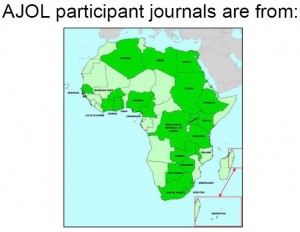
Figure 1a: Distribution of Journals in Africa (used with permission from Ms. Murray)
View Map of Africa in a larger map
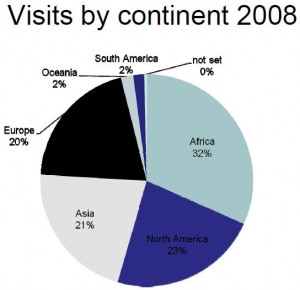
Figure 2: Visits by continent (used with permission from Ms. S. Murray)
(3) Comparison of old and new systems
After the overview and elaboration of the users and stakeholders of AJOL, Ms. Murray went into the details of the AJOL on OJS 2.2.2. She expressed the benefits of such a partnership with PKP led to better upgrading of the system. She found that more advanced versions could also be complied and were easier to upload which allowed for more capabilities in the platform that were not possible before. Figure 3 shows flowchart of the software and resources used ending with final product of the Open Journal Systems coded through the PHP scripting language using MySQL as the database management tool in the APACHE web browser run from the Linux operating system.
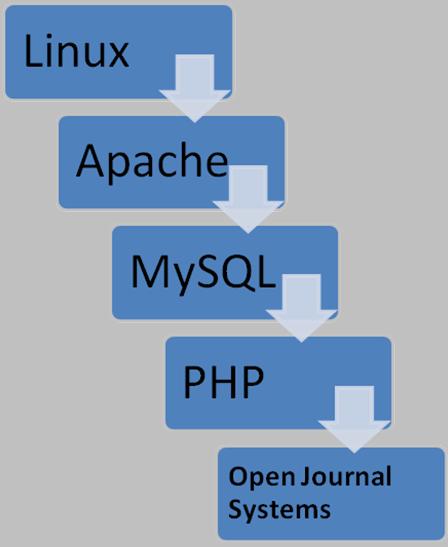
Figure 3: Software and Resources (created by Pam Gill)
A comparison of the new and old system is shown in Figure 4. The new approach is useful for all parties involved and is an excellent search tool with a new look and feel. Currently, as of July 2009, journals now manage their own AJOL pages in terms of the workflow management. In the future, Ms. Murray envisions that journals will be able to host their own versions of OJS on the PKP harvester which acts as a metadata aggregator. The newer versions will include a statistics package and offline plug-ins when connectivity is interrupted. The offline plug-in option will be crucial for users living in remote areas. Eventually, Ms. Murray envisions all journals being independent and managing their own pages.
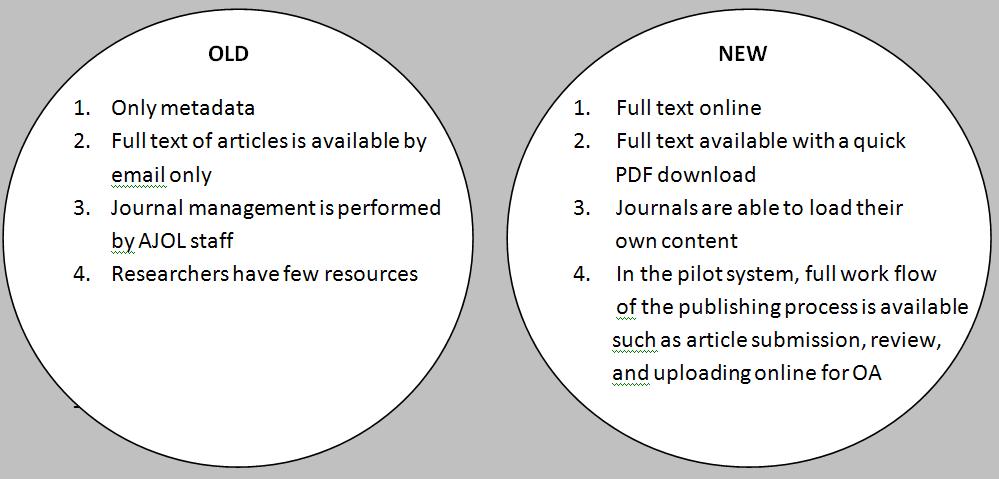
Figure 4: Comparison Chart of Old and New Systems (created by Pam Gill)
To conclude her presentation, Ms. Murray placed great emphasis on the need for the flow of global information from the North to the South (Evans and Reimer, 2009). She stressed the implementation of a new business plan that would allow journals to consider OA as a more viable possibility via AJOL/PKP. The full OJS functionality on AJOL has already made a huge difference as discussed earlier as open source software (OSS) has matured considerably. To summarize Ms. Murray ended her presentation one two key points to promote and continue the dissemination of literature in developing countries. First she brought forth the importance of carefully selecting the best tool that will take into account the needs of the users. Next, she advised to carefully align yourself with partners that you trust and who will support your initiatives for the right reasons. The following quote from Ms. Susan Murray herself summarizes these points:
“Relationships and communication are still the drivers of success, the technological tools are just the vehicle.”
– Susan Murray (2009)
This quote from Ms. Murray is used to illustrate that the technology can help propel the dissemination process in varying capacities. Technology depends on the specifications and limitations of the hardware and software. Yet, at the end of the day, relationships with others are the most important in terms of communicating, working collaboratively sharing ideas, which will ultimately lead to the success (or failure) of your goals and aspirations.
Questions from the audience asked at Ms. Murray’s session:
Question: Is AJOL published in other languages (referring to Figure 1 of African map from Susan’s PowerPoint slide)? Does AJOL have plans to bring more non-English journals to the portal?
Answer: Yes, we are hoping to introduce this to Francophone countries by starting the process of translating to French. So there will be an English/French option. We have a few journals published in Portuguese, Arabic. If we have a journal that is online (and space is NOT a problem) then we can publish in a local, indigenous and international language. Then at the same time research can be read by the local community and broadly by the rest of the world. This will increase readership and the journal will have met the needs to satisfy the best of both worlds.
Related Links
Conference attended by Susan Murray
Software/Sites
- African Journals Online
- OJS 2.2.2 Download
- PKP Open Archives Harvester: free metadata indexing system
References
Evans, J.A, & Reimer, J. (2009). Open Access and Global Participation in Science . Science. 323, 1025
Murray, S. (2009). Open journal systems (OJS) software as used by African journals online (AJOL). PKP Scholarly Publishing Conference 2009. Retrieved 2009-07-09, from http://pkp.sfu.ca/ocs/pkp/index.php/pkp2009/pkp2009/paper/view/216
July 11, 2009 1 Comment
Maximizing the Reach of a Graduate Research Journal Through Open Source Tools and Social Media: The Session Blog
Presenter: Rajendra Bose
July 10th, 2009 at 3:30 p.m.
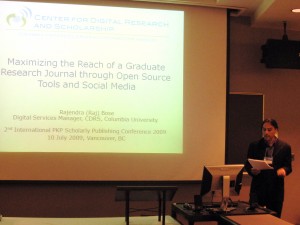
(used with permission from Raj Bose)
Background Info
Cultural Formations is an online journal (due to launch next month) that is open-access and peer-reviewed. The Center for Digital Research and Scholarship (CDRS) collaborated with Columbia University’s Teachers College to form Students for a Cultural Studies Initiative (SCSI). This project has grown to become more than just an online journal, using the concepts of Web 2.0 and Social Media as well as a research repository, Academic Commons.
As quoted on the Cultural Formations website, the journal-plus project has “…three integrated elements: an online journal of peer-reviewed articles, a blog for discussion of published articles and works in progress, and a wiki to serve as a “Wikipedia” of cultural studies and education.”
Session Overview
Graduate students at Columbia University and the Teachers College joined forces to form SCSI. Over the past year, they have worked hard to start a “journal-plus” – an online space that looks at cultural formations including youth culture, media, music, art, film and ethnicity, etc. Their goal is to not only publish research but to be accessible to the entire community, not just academic scholars. Along the way they were faced with significant challenges (examples include web design, technical problems with layout of the vastly different programs and challenges from having multiple partners with decision-making authority). They are however on schedule to launch their site next month. (Please stay tuned to this blog for the launch announcement!)
Services they hope to provide
- Publications – e.g. online books, journals
- Conferences
- Academic Commons
- Wikischolars
An example of what their website will look like:

(Used with permission from Raj Bose)
The goals of the Cultural Formations site are three-fold:
- authority of a journal
- immediacy of a blog
- what’s new and emerging in wiki format
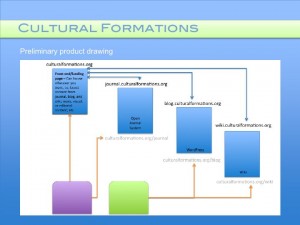
(Used with permission from Raj Bose)
The site is scheduled to launch in August 2009 at Culturalformations.columbia.edu (URL may change prior to launch).
Questions from the audience
1. Impressive. Will you open this up to the public as open source?
Yes, we are using all open access materials. The idea is to share it with the rest of the community, Users may have to connect with us to get a user profile as it may be too expensive to allow it open to all users at once. There likely will be a basic free level, and we may charge for some of the more advanced functions. We feel the site will have longevity with the article content/repository.
2. Is there a similar movement in other universities?
Yes, but the idea right now is to work with university presses and authors right here to get the right agreements.
3. Is there going to be any co-ordination with other groups?
Already there are 50-100 student journals with OJS [Open Journal System]. You especially want this system for longevity when a student group starts to fade out, this will help. The university hosting this site will help keep those groups up and running.
4. What about groups with other levels of education and how this may be used?
This idea is not a typical journal, but the idea to connect a blog and a wiki so that other members of community can join or help is amazing and very inclusive. Because of this, there will only be a light peer review. They partners want to keep this as open as possible.
Related Links
Center for Digital Research and Scholarship (CDRS)

Open Archives Initiative Object Reuse and Exchange (OAI-ORE)
July 10, 2009 Comments Off on Maximizing the Reach of a Graduate Research Journal Through Open Source Tools and Social Media: The Session Blog
Creating an Open Access Journal; A Medical Students’ Prospective: The Session Blog
Presenters: Steven Andrew Plato II and Andrew James Wyman (remotely), David Solomon in-house
July 10th, 2009 at 3:30 p.m.
Background info
Steve Plato and Andrew Wyman are third-year medical students from Michigan State University who saw a need in the literature for a dedicated place for medical students to publish their work and founded The Medical Student Research Journal (MSRJ) in 2007. They are due to publish the first issue this fall.
Session Overview
The session got off to a rough start with a few technical difficulties (due to new too-loud speakers in the meeting room at Simon Fraser University). The students gave the presentation from their editorial room in Michigan via Adobe Connect Pro. They use this to connect with the many geographically diverse authors/editors/faculty associated with their journal. The image, Powerpoint and voice are very clear. This is an exciting software tool for all distributed learning models.
The students went on to explain that they started the journal to fill a gap. Most students have extensively researched their chosen field of specialty throughout medical school, but often do not know how or where to publish their work. Whereas 60-100% (depending on specialty) of medical students matching to their first-choice residency stated they had extensive research in their field, the proportion of those that had published was as low as 35% for some specialties. MSRJ is peer-reviewed, authored and edited entirely by medical students which they hope will be the go to journal for medical students to publish that work.
This project was started at the Michigan State University but the creators hope to reach medical students throughout the US as well as internationally. THE MSRJ uses Open Journal Systems (OJS) and Creative Commons licencing to ensure communication and availability of publication to all medical students. This project is similar to a one started a few years earlier by the same institution (MSU) in a graduate biotechnology course (see session blog from this conference) however on a much quicker timeline, around 28 days!
OJS has been very helpful for the med students as it helps to facilitate their multi-location system, has low overhead and allows them rolling publication with minimal delays. They also like the management tools that help to guide novice editors (reminders/checklists) to make the process simple. OJS also tends to being in a larger readership.
Faculty
Faculty assure quality peer-review. Students are trained by faculty in critical appraisal, principles of scientific writing and academic integrity. They are also able to review a mock article and can compare their reviews to similar good and poor examples to learn to become a better reviewer. Faculty also provide guidance on sustainability and establish good practice in mentees (more hands-on and one-on-one time with people who know the literature the best). The students all go through an online training module, from the Annals of Emergency Medicine, prior to starting as well.
Usually one faculty will mentor 3-4 students per article. This helps less experienced reviewers in specific fields. They also provide feedback and guidance on where a review may be lacking. Students can then re-review and submit, then the editor decides to accept, accept with revisions or decline the article.
Sustainability plans?
Many other journals before this have struggled with longevity. MSRJ have instituted a student replacement policy (juniors that will take over when the current editors are done) and training sessions for editors which serve as quality control. In addition a letter from the Dean will be placed into the student file for encouragement to participate and to continue the job. Faculty are also rewarded by recognition in published material as well as a formal letter to their respective Departmental Chair. An annual report with statistics on publications is also planned for accountability
Finances?
The students plan for this journal to be a free or very low cost venture. All labour is by students or faculty. There is a minimal cost for the website host, however their major cost is copyediting, which they hope will be eliminated by using university resources. XML generation is also a marginal expense as is website development.
Benefits
The students feel the benefits are quite clear. They build experience in scientific writing and editing as well as get a head start on publications for their career. It is also strongly beneficial for those students doing research outside academic centres such as rural and distributed sites.
Since Open Journal System (OJS) has become a forerunner in educational resources, many other institutions have been able to start similar projects, with one just ready to launch this fall here at my home institution, UBC. The UBC Medical Journal will provide medical students with a forum to publish their research work that previously had no definitive place for publication.
Questions from the audience
1. I understand medical school is an intense experience. Do you have to sacrifice other parts of the educational experience to participate?
While it is true it is intense, but one thing about medical school is it does allow you to do things outside of school. Most students are involved in extracurricular activities already and 60-100% already involved in research. There will be some sacrifice, but usually that would be less time for research projects (i.e. one instead of two). The time intensity of the reviewer part of the job is not significant. Students only review one article at a time. There is a base here already, but it does take away time, hopefully that time is well spent.
2. Are the training materials you used publically available?
Yes they are online in the Annals of Emergency Medicine Journal. They have a great online flash based training process that we used.
3. Do you plan on only accepting articles from MSU or do you plan to open the journal up to other universities?
This journal will be open to med student/residents around the world once it is started. MSU is unique in their distributed plan in the states. Right now, you can submit from anywhere, but we hope to expand reviewers across the country.
Related links
The Medical Student Research Journal
Andrew@msrj.chm.msu.edu
Steven@msrj.chm.msu.edu
dsolomon@msu.edu

July 10, 2009 Comments Off on Creating an Open Access Journal; A Medical Students’ Prospective: The Session Blog
Who knows what, when? Current and desired capacities for online journal statistics gathering and dissemination: The Session Blog
Friday, July 10, 2009 @ 9:30
SFU Harbour Centre (Earl & Jennie Lohn Rm 7000)
Presenters:
Andrea Kosavic (Digital Initiatives Librarian at York University)
James MacGregor (PKP Associate)
Session Overview
James MacGregor and Andrea Kosavic outline their efforts to provide a suitable recommendation to Synergies Canada on what they should provide in terms of statistics and to whom based on a survey of current and desired practices in online journals. Kosavic explained that her interest in participating in this study stemmed from having multiple statistics requests at once at York and being overwhelmed by the lack of a streamlined method of reporting this information.
Commentary
In trying to establish a recommendation to Synergies Canada regarding what statistics should be collected and shared, Kosavic and MacGregor proceeded to:
1) establish what is currently supported or lacking.
2) survey journals and repository holders to see what they actually need.
3) draw up recommendations.
Using Open Journal Systems (“OJS”) and Erudit Consortium as targets for recommendations, the following was initially noted:
– they do not share common statistics collection;
– both can capture the number of items viewed per month (with the help of external software);
– other statistics are difficult to capture; and
– both have reporting functionalities.
Key questions were asked of respondents in order to frame findings with 75% of respondents claimed that their current statistics collecting solution was not satisfactory.
Key findings include:
– 51% of OJS users utilize the built in reporting tool.
– 30% of respondents use 2 or more tools.
– Identifiying the number of “unique visitors” was deemed the most important statistic.
– Web pages accessed and page clicks were identified as the most collected statistics.
– RSS feed information was identified as the least collected statistic.
– Statistic collection ranged from monthly to quarterly to yearly with no significant majority.
In regards to the sharing of statistical information, the survey indicates that a significant gap exists between who journals are currently sharing statistics with and who they anticipate sharing statistics with.
Kosavic and MacGregor learned that there appeared to be no ideal statistical management system. The speakers were asked by someone in the audience about whether or not it will be possible to tell whether or not an end user is actually reading an article and if so, how much and what is being cited (if anything). MacGregor explained that this statistic was not collected and that there is currently no way to track this information; another member of the audience compared it to trying to be able to track how much of a book a library patron read. Ultimately this would be ideal to be able to track but unrealistic in the near future. It was also noted that referrer statistics were not included in the survey, that is, information related to how viewers came to find a journal site/article.
Recommendations for statistical gathering and disseminating:
– should standardize on 3rd party reporting across all nodes;
– use SUSHI protocol to collect statistics;
– implement COUNTER protocol to collect statistics;
– extend COUNTER to cover other Synergies items.
At different points in the presentation, MacGregor showed a different visual representation based on his gradually refining understanding of current and desired capabilities and the flow of statistical dissemination. This was helpful in demonstrating that initially there were many complicated methods of statistic collection and possibilities but eventually, with greater understanding, MacGregor was able to illustrate an easy to understanding model for statistic management.
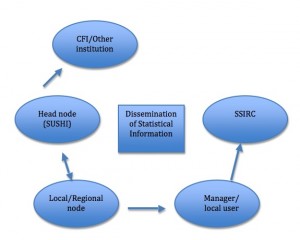
(Figure 1.0 – Final visual representation representing a steamlined view of the dissemination of statistical information)
Stakeholders, statistics desired and relevant protocols have been identified and the final report is in the process of being completed.
Related Links
July 10, 2009 Comments Off on Who knows what, when? Current and desired capacities for online journal statistics gathering and dissemination: The Session Blog
Enriching Digital Citation Networks using Web 2.0 Principles: The Session Blog
Presenter: James Williams, Session Abstract

July 10, 2009 at 4:30 p.m.

Photo taken at PKP 2009, with permission
Background
James Williams is Manager, Information Systems at the eScholarship Research Centre at The University of Melbourne (http://www.esrc.unimelb.edu.au). His background is in Computer Science and Linguistics. James’ work focuses on eResearch and eScholarship, archiving and print on demand.
Session Overview
This session was a technical session, which laid the context and groundwork for a plug-in aimed at leveraging the network for citations. This session also highlights that some of the features of this plug-in are about to be implemented in the Referral plug-in coming with OJS 2.3. The author is planning to take his plug-in further by building on the work that has been done with the OJS Referral plug-in.
The context and groundwork included: Scholarly Contribution and Statistical Measurement; Bibliometrics – the h-Index and Journal Impact Factor; Indexes, Citators, Aggregators, etc.; What is Scholarship? What is Significant?; Developing Online Research Support Infrastructure; Scope – Scholarly Publishing and OJS Development. The key driver behind the paper had been to lead up to a plug-in which could capture and expose citation data, though this has been, to a certain extent, scooped by the Referral plug-in in the coming OJS 2.3. So OJS created a “heart broken Australian”, though one who is expected to make a full recovery.
In Australia, extensive dialogue around the measurement of academics’ scholarly research. Much of this is controversial. One key measure discussed is citation measures. Two citation measures come up in these discussions: the h-index and the journal impact factor. Many questions have been raised about this and attempts made to improve these measures, but questions remain about the extent to which they can be relied upon. The h index is from a paper by Hirsh, (2005). Crudely, it is the average number of citations that an author’s publications achieved in a year. Though its calculation is more complex than this.
Further problems with citation measures include statistical considerations with these measures which vary greatly between disciplines, so citations counts can vary greatly for statistical reasons. The source of these citations is the different indexes (Scopus, ISI Web Of Science, PubMed, Google Scholar) though each of these measures citations differently.
So, in general, what is needed is to develop intelligent digital citation networks, increase the discoverability of significant research contributions, harness the footprints caused by active network behaviour, provide greater statistical detail for transparency, and surface this information as much as possible for richer bibliometric reporting.
So, more specifically, what is needed is to track referrer information where it’s available: referring website/link/journal, date of referral and number of incoming hits from each referrer. As each referring URL, site, or journal is detected, it then becomes a known information source – an external, digital citation. We then surface this URL, site, or journal on the originating journal. Users of our (originating) journal, unaware of the external citation, can then find other people referring to this resource, and so, the networked community expands, develops, and evolves. This is the intent behind our planned digital citation plug-in, but which, as previously mentioned has been partially scooped by the Referral plug-in in OJS 2.3. So we are going to look at the Referral plug-in and talk further with PKP about this and build on the work that PKP has done.
Session Questions
Q. I’d like to know more about the h index?
A: Hirsh (2005) and others have expanded this. Peter Jascoe has also written a paper on this
Q. What software should use would where citations need to be checked in the publication process? How can we auto check and fix citations?
A. For OJS, the Resolver plug-in will help. L8X could also help.
References and Related Links
eScholarship Research Centre, University of Melbourne
Hirsh, J.E. (2005). An index to quantify an individual’s scientific research output. Retrieved on July 12, 2009 from http://www.cs.ucla.edu/~palsberg/hirsch05.pdf
Top Scholars in Computer Science, as calculated by the h index
What is Web 2.0? (includes translations in Chinese, French, German, Italian, Japanese, Korean, Spanish)
July 10, 2009 Comments Off on Enriching Digital Citation Networks using Web 2.0 Principles: The Session Blog
The Latest Developments in XML Content Workflows: The Session Blog
Presenter: Adrian Stanley, Session Abstract
July 10, 2009 at 11:00 a.m.
Background
Adrian Stanley is the Chief Executive Officer for The Charlesworth Group (USA). Prior to this Adrian worked for 4 year as Production Director for Charlesworth China setting up their Beijing office. The Charlesworth Group offers cutting edge automated typesetting services, as well as Rights and Licensing opportunities for publishers in the China market. Adrian is an active committee member for the SSP (Society for Scholarly Publishers), The Association of Learned and Professional Society Publishers (ALPSP North American Chapter), the Council of Science Editors (CSE), as well as working on a key project with the Canadian Association of Learned Journals; he has 20 years experience working in the publishing/printing sector.
Session Overview
This session was a technical session, yet one which tried to keep the technology basic and focused more on the benefits of the technology for the publishing process, particularly the benefits of XML. Charlesworth works with XML and XML workflows. Their aim is to support publishers. This session showcased their tools.
The benefits of using XML are the automation and time saving in the publisher’s workflows. But more fundamentally XML adds energy to data. The presenter took a short poem and showed it as text, then HTML then XML. The change in the poem was less how it looked than what it now was. In XML, it now had substantial additional information encoded with the poem.
Benefits of XML are numerous, adding more information and data about an article, data that is both machine and human readable. The presenter referred to the excellent pre-conference workshop in the PKP 2009 conference by Juan Pablo Alperin for further information on XML.
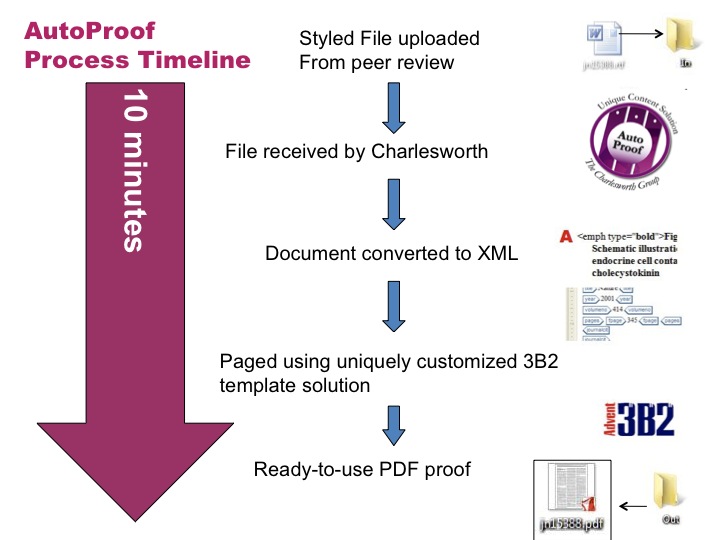
Image taken from presenter's presentation at PKP 2009, with permission
AutoProof Process Timeline diagram highlights the 10 minute process that Charlesworth’s AutoProof performs. It takes a styled file, converts it to XML and then outputs it in production ready PDF format. Charlesworth provides some Microsoft Word macros that help apply tagging and styling, to prepare documents in Microsoft Word for import to this process and ultimately XML. The presenter took us through this process showing each stage.
The presenter then showed the Online Tracking System that allows a view into each stage in the AutoProof process. From one screen, the publisher and editor can run the entire publishing process.
Next some examples of the many other types of AutoProof publications that are possible were shown. It’s not just journals e.g. program and abstract meetings, ebooks, dictionaries, etc can be handled. As long as files coming to AutoProof are structured, many types of documents can be used and created. So what AutoProof is doing is simplification and reduction of time in the workflow process, using XML at its core.
In addition AutoProof supports incorporating XML into the PDF, to make PDFs more readable and searchable. Storing the metadata in the PDF file (using XMP) could make it much easier to import a large collection of PDF files into a reference manager. XMP combines XML metadata within the PDF file. The presenter showed a sample XML Packet (XMP) page.
Other applications and developments with XML are also possible including auto generation of table of contents and Index, author proofing of link to PDF form XML, creating XML in multiple DTDs (document type definition), etc.
So in summary the goals of AutoProof are to enhance publications, customize how much or how little the publisher wants to do with XML, provide integrations with other systems and provide the basis for further developments e.g. authoring templates. Lastly, the presenter showed an example of OJS journal using AutoProof. Every reference automatically picked up the DOI (Digital Object Identifier) and automatically creates web links to the references.
Session Questions
Q: How much of publishing workflow did the James Journal use?
A: The James Journal allowed forward and backward linking, see the references in this James Journal article. They used most of our services; most fundamentally we created the XML. Because they used a lot of our services they were able to publish this magazine with a part-time editor.
Q: What about integration with OJS?
A: So we are working on creating integration with OJS
Q: What are the costs?
A: Broad range, depending on services that you need. The important point however, is to start to work out how much the alternatives of using your staff time is in fact really costing you. That is where we can help you make savings by significantly reducing the amount of staff time you need to dedicate to the publication process.
References and Related Links
Charlesworth Group launches new open access OJS journal
DTDs (document type definition)
DOI (Digital Object Identifier)
July 10, 2009 Comments Off on The Latest Developments in XML Content Workflows: The Session Blog
Do Not Press Print: What Can We Do to Keep the Reader Engaged in Online Use of Journals?: The Session Blog
When: Friday, July 10, 2009 3:30pm – 4:30pm
Room: Main Concourse – Fletcher Challenge Room 1900
Presenters: Rick Kopak, Chia-Ning Chiang
Rick Kopak is an Assistant Professor at the School of Library, Archival, and Information Studies, UBC. Chia-Ning Chiang is a PhD Candidate at the School of Library, Archival, and Information Studies, UBC.

Chia-Ning Chiang and Rick Kopak (Source: Photo taken by Helen Szeto)
Session Overview:
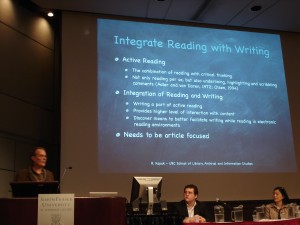
Rick Kopak presentation (Source: Photo taken by Helen Szeto)
The purpose behind this session is to look at ways to engage journal readers through the journal’s interface. Rick Kopak and Chia-Ning Chiang presented a series of reading tools in the Open Journal System (OJS) that will critically engage readers as they read through the articles. They want to provide an environment that enables an active reading process where they are thinking about the information as they read.
The reading tools will help the reader focus on the article and interact with it. Also, the reader can bring in other related information on the topic; making connections in the process. Kopak gives examples of reading tools found in other models: highwire press, PubMed and PIRA (Personal Information Retrieval Assistant).
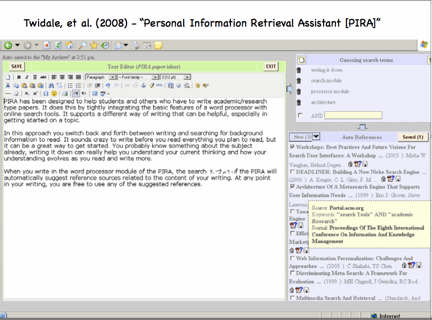
PIRA screen capture (Source: slide courtesy of Rick Kopak)
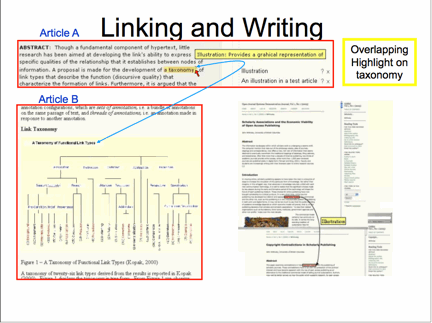
Linking and Writing (Source: slide courtesy of Rick Kopak)
For the prototype of reading tools being developed for OJS, there are two components: annotation and linking. Writing annotations allow the reader to capture their thinking process as they read. They also provide a visual search of ideas on the sides of the article. In the prototype, readers can highlight text and space is allotted on the side for notes. Linking and link typing are extensions of annotation. Readers can link to another piece that elaborates on the article topic. The idea behind linking is to capture relationships between different journals and make connections.
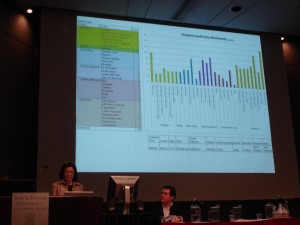
Chin-Ning Chiang Presentation (Source: Photo taken by Helen Szeto)
During Chin-Ning’s part of the presentation, she reviews a bar graph chart that compares the features of reading tools from 2006 to 2009. There are social components to article reading as well. Reader comments can be found at the bottom of the page. Chiang argues that comments at the bottom of the page are ineffective because people rarely scroll down to the bottom. Also, readers lose context when they scroll away from the text.

reading tools chart (Source: slide courtesy of Rick Kopak)
There are 5 parts that Chiang and Kopak would like to include in their production version of OJS reading tools: highlighting, note making, workspace, public views, and linking. Chiang and Kopak would like the reader to have more control over highlighting, including the choice of colours and tone densities. For note making, readers would be able to toggle the note function on and off, and have the ability to fold long notes. A workspace will also be created for people to start composing and clipping notes and text to the workspace. In the public view mode, individual markings can be shared which promotes social interaction among academics. It allows readers to view the multiple commentaries in an article. Finally, the linking function will give the user more control. Some of these abilities include clicking links off and on, creating hyper links and being able to tag annotations and highlighted text.
(Source: powerpoint presentation courtesy of Rick Kopak)
Session Analysis:
Chiang and Kopak were clear on their intentions on creating reading tools for OJS. They referred to existing reading tools to show improvements they wanted to make. The screenshots of the various interfaces were helpful visuals to understand the different tool functions. The rationale behind each component and their beneficial functions were clearly explained to persuade the audience that the reading tools will enrich the reading process greatly in OJS.
Session Questions and Answers:
A gentleman in the audience posed the following questions: What about the editorial view? Can we apply these tools there?
I couldn’t hear the reply clearly, but Kopak sent me an email reply to the questions asked.
Kopak’s reply: “The gentleman’s question concerned whether we ever thought of using the Annotation and Linking Reading Tools for the Editorial view in OJS in addition to the Reader View. I said yes, we had considered it, and it might be a feature in the Editorial View at some point in the future. But, at the moment, we were focusing on the readers of OJS journal articles. In the Editorial View, editors and reviewers could comment on journal articles directly using the Annotation Tool specifically, and editors could give editorial instructions as well.”
Related Links:
- School of Library, Archival and Information Studies, Univers
- PKP 2007 – A Multi-dimensional Approach to the Study of Online Annotation (presented by Rick Kopak & Chia-Ning Chiang)
- OJS Help – Reading Tools
July 10, 2009 Comments Off on Do Not Press Print: What Can We Do to Keep the Reader Engaged in Online Use of Journals?: The Session Blog
Knowledge production through scholarly publishing in sub-Saharan Africa: a bibliometric analysis of the period 1996-2007
Presenter
Ezra Ondari-Okemwa, Senior Lecturer and Head, Department of Library and Information Sciences, University of Fort Hare, South Africa.
Session Overview
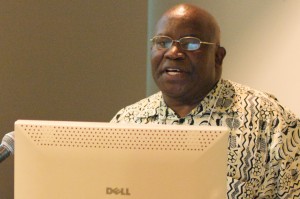
Photo: J. Miller - PKP Conference
Dr. Ondari-Okemwa introduced his talk by explaining that his research specifically focused upon the sub-Saharan region of Africa during its most productive period in terms of knowledge production, 1996-2007. The level of scholarly publication in sub-Saharan Africa is of critical importance, as this activity enables scholars to share what they know with their peers within the region. Such activity, researchers in sub-Saharan Africa can create new knowledge rather than only relying on scholarly research that emanates from the developed world.
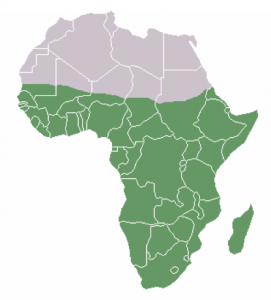
A map showing the boundaries of sub-Saharan Africa – South of the Sahara Desert
Ondari-Okemwa’s called into question the accuracy of indicators of scholarly publication from sources such as Thomson Reuters as its data focuses predominantly upon publications from North America, Europe as well as publications in the English language. He also identified that knowledge production was not uniform and took at least two dominant modes, only one of which benefited from the funding sources typically available to African researchers. The first mode of knowledge production is a linear one, one that is almost exclusively academic, investigator focused and discipline based. This mode of knowledge production leans heavily on scholarly publication. The second mode, one that started to emerge in the mid-twentieth century is far more context and problem-focused, with an interdisciplinary and reflexive orientation. This mode leans more towards the types of knowledge production we see in emerging interdisciplinary academic disciplines such as Developmental Studies, Knowledge Management and Gender Studies. This latter mode, seems particularly under-represented in the data on sub-Saharan African scholarly production, in part because funding sources are less likely to be found for such research in the social sciences than, in say, Medicine or Science. As such, the majority of the scholarly publications that were published during the time-period of the study (1996-2007) show a strong emphasis on science-based disciplines. Other disciplines were not widely represented.
Ondari-Okemwa also spoke to the potential benefits of Open Access and electronic journals in the context of scholarly activities in sub-Saharan Africa, specifically, and in Africa in general. Without question, the availability of such resources has had a positive impact on the research connections between the leading institutions. Such resources can be readily and exhaustively searched, readers can quickly move from citations to the cited works themselves with a single click, and the full range of bibliographic references are easily available and retrievable. However, a general state of technological deprivation in sub-Saharan Africa excludes most scholars from contributing to knowledge production in the region.
Ondari-Okemwa identified several key hurdles to scholarly publishing and knowledge production in Sub-Saharan Africa:
- There is little or no use of locally produced knowledge
- Invisibility of scholarly publications emanating from sub-Saharan Africa
- Technological hurdles such as poor Internet connectivity and low teledensity
According to Ondari-Okemwa, governments in sub-Saharan Africa need to address issues such as low and eroding salaries, social unrest and political conflicts including war, to address the reasons why so many people leave the region. In concluding, Ondari-Okemwa acknowledged the many strategic challenges facing most institutions of research and learning in sub-Saharan Africa, but felt strongly that steps needed to be taken to ensure higher rates of production of knowledge. These local scholars must play a role in this as they are best-placed to produce such knowledge about the region.
Question period
During the question period, several issues raised by the audience focused upon infrastructure challenges within African universities and the pressure upon scholars within those institutions to conduct their research in areas of interest to the developed world. Many in the room made reference back to the hurdles to scholarly publishing earlier mentioned by Ondari-Okemwa and to the fact that connectivity is a critically important factor that is limiting the possibilities for universities throughout Africa to engage more fully in research activities. With respect to funding for research, one audience member questioned whether or not the World Bank model of development really calls for the production of new knowledge from African countries. More often, it seems to narrowly task universities to reproduce existing research and to focus instead on increasing numbers of graduates in areas that align with its definitions of economic growth in the region. Ondari-Okemwa acknowledged that universities were increasingly being asked by government to shift to the mass production of graduates. The universities are caught up in a struggle with increasing enrolments without a concomitant increase in funding sources, and this results in fewer opportunities for scholars to focus on research activities.
Another issue that came up during the question period concerned the invisibility of many African scholarly journals. There are hundreds of journals that are not online and not visible being hidden within institutions and only available to a limited number of scholars and readers. Ondari-Okemwa responded by saying that it will be difficult to change this situation, though initiatives like African Journals Online is helping to make African journals more visible.
Related Links
Ondari–Okemwa, E. (2007). “Scholarly publishing in sub–Saharan Africa in the twenty–first century: Challenges and opportunities.”
First Monday, Volume 12 Number 10 – 1 October 2007
Ondari-Okemwa, E. (2004). Impediments to promoting access to global knowledge in sub-Saharan Africa. Library Management, 25(8/9):361-375.
Ondari-Okemwa, E. (2002). Challenges of harnessing virtual information resources: the case of the African Virtual University. Journal of Information Science 28(4): 321–329.
July 10, 2009 Comments Off on Knowledge production through scholarly publishing in sub-Saharan Africa: a bibliometric analysis of the period 1996-2007
Understanding Impacts and Implementations of New Knowledge Environments: The Session Blog

Dr. Ray Siemens presents at PKP 2009. Photo by C. Gratham
Presenter: Dr. Ray Siemens, Director, Implementing New Knowledge Environments (INKE) Project. Canada Research Chair in Humanities Computing and Professor of English, University of Victoria. Bio
July 10, 2009, 2:30 pm-3:00 pm. SFU Harbour Centre. Rm 1900
Background
The INKE project represents the interdisciplinary work of researchers with specialties spanning humanities, text analysis, information studies, usability, and interface design. The team consists of 35 researchers, 20 institutions, and 20 other partners. Their SSHRC funded work takes a scholarly approach and cast an eye back on the history of the print medium to help understand the roles digital books might play in the future.
Session Overview
After providing an over-view of the team and project, Dr. Siemens summarized the motivation for the study by stating that e-books and e-textuality have “an exciting future … but an inconvenient present”. The exciting future can be illustrated by how pervasive various digital forms of text have already become in society today. But the inconvenient present lies in how little we actually know about this new media form and how the gaps we need to fill before we can make decisions about how to best use this “new knowledge machine”.
We still have a long way to go. As Dr. Siemens reminds us, “the e-book is still just a pale representation of it’s paper counterpart.” He suggests that one of the main reasons for this is that we still model electronic documents to mimic their print based forms and in doing so we import the same conceptual models from the print world. To achieve the benefits of e-books and documents, Dr. Siemens says that we need to reconceptualize these core critical and textual models.
The team’s research is clustered around the following four interdisciplinary areas: textual studies, user experience, interface design, and information management. And through these clusters they have identified a number of gaps in the existing knowledge leading to the following research questions:
- Has the way we read and experience information changed since the rise of the Internet, and, if so, how?
- How do different knowledge environments influence the way we engage and use information?
- What new features can we design to improve digital information environments and their interfaces?
- How can we better design the data that underlies and serves the needs of those using such digital information environments?
- How does this interdisciplinary team work together to achieve our research objectives given the multiple lenses through which they approach the same questions?
Dr. Siemens closed his presentation with three “Rubber hits the road” impact questions:
- Can the humanities find this problem worth engaging with?
- Can the interdisciplinary cores yield something tangible?
- If so, will the results be socially applicable, embraceable, and ubiquitous?
Questions
Time limitations did not allow questions for Dr. Siemens
Related Links and References
July 10, 2009 Comments Off on Understanding Impacts and Implementations of New Knowledge Environments: The Session Blog
Socializing and Disseminating the Academic and Intellectual Creation: Experiences from La Plata National University: The Session Blog
Date: July 10, 2009
Presenters: Gonzalo Villarreal, Marisa Raquel De Giusti

s13610, “Feet” January 27, 2009 via Flickr, Creative Commons Attribution. La Plata has a sandbox for OJS and OCS users to get a "feel" with templates!
Session Overview
This presentation was delivered by Gonzalo in real time through Skype.
Background on La Plata National University (UNLP)
He described UNLP as a major university in Argentina and Latin America. It has more then 90 000 students and 10 000 employees, including staff and administration.
About UNLP:
They produce journal articles, degree essays and theses, multimedia production, books and e-books and other products.
History of Development
In 2003, UNLP launched the Intellectual Creation Dissemination Service, SeDiCi, for 2 purposes:
– to provide authors a means to publish
– to benefit society for all it has invested in the university
The original plan of the university was to receive, digitize, catalog and upload documents to the SeDiCi website, but software was needed. After an extensive worldwide search, the team felt they had to design their own software. Celsius-DL was the answer to complete the service to scholars. It has since been recognized as the OEA’s award in 2005 as the best Digital Library in America.
Celsius-DL supports a free scheme and is used to configure a wide range of materials. It exports to Dublin-Core or Marc21, is a data and service provider and it is built on open source technologies.
Since 2007, UNLP has recognized the importance of disseminating academic and intellectual creations. Journals also were seen as crucial to disseminate, so SeDiCi was expanded to include them. In October, 2008, UNLP launched the Journals Portal. Pre-existing and new publications are both accepted. Authors publish through a review process, easily communicating with other authors, reviewers and editors. OJS was chosen as the platform for them to use.
They then decided to create the Congresses Portal. This helps groups and others organize meetings. PKP’s OCS was selected to supply the service. SeDiCi’s team offers user, systems and technical support to users, but they had to overcome some obstacles and learn how to use it.
Obstacles and Solutions
- Obstacles included many words or phrases in Argentina that were different from Spain. Corrected translations are now complete. In service to others, they are also available on PKP’s website for download.
- In addition, some OCS users needed to use some LaTex in their abstracts. None were available, but they are now available as a plugin.
- Next, the UNLP main website was comfortable for users, so the Journals and Congresses websites have been adjusted to look similarly. A comparison may be seen on-screen to show the similarities.
- Further, templates are available for users uncomfortable with changing them, but wanting to meet their own needs. OCS and OJS is fully customizable by editing a CSS file. Many CSS styles were made for publishers to choose from because not all had web designers to make changes.
- Finally, workshops online have been offered. Users can see an overview to see what the software is capable of and what it won’t do. There are workshops for users and workshops for managers. They have a “sandbox” area where users can try things without affecting the real system.
Note: the voice link with Gonzalo was lost in the last 2 minutes of his presentation. We hope all essential concepts were conveyed.
Blogger’s Thoughts:
The workshops sound tremendously helpful for users and managers. The sandbox feature is very practical and should be of interest to many. A great deal of work has been done to provide leadership in Argentina and its metron of influence. While the audio feed accomplished the task, it would have been good to see them in person to be able to ask questions and benefit from their experience. I was particularly interested in how their design of Celsius-DL provided benefits not found in software as a result of their worldwide search.
In light of the work so many other libraries and institutions are doing to promote the dissemination of scholarly knowledge and research, through either the use of OJS and OCS, one thought seems to echo through the workshops. It is a “cry” for collaboration and communication. From sharing experiences and collaborative problem-solvingj, to establishing some form of index standard are common issues shared by Mexico, the U.K., Canada and others. I hope a leader emerges and this is actualized.
While this is recognized as a technically-themed presentation, I wondered how much use of open journals resulted from their work. While I couldn’t access this information, I was able to view a page on their website that revealed how many “hits” they’ve had at SeDiCi and how many registered users they have. I was surprised that the vast majority originated in the United States! Journal numbers, particularly open journal numbers would be of interest to many at the next conference.
Presentation Link to be provided by conference organizers.
Presenter Links:
Gonzalo Villarreal [The blogger lacked the language to translate, but has listed some found on the SeDiCi repository!]
A Linux publication
Co-authored, in Portugese: Manuscript Character Recognition Overview of features for the Feature Vector
Marisa Raquel De Giusti
Simulation framework for teaching in modeling and simulation areas
Storage of Simulation and Entities History in discrete models
Article by both outlines the history of their work at La Plata in more detail.
Related Links
PrEBi at La Plata National University
July 10, 2009 Comments Off on Socializing and Disseminating the Academic and Intellectual Creation: Experiences from La Plata National University: The Session Blog